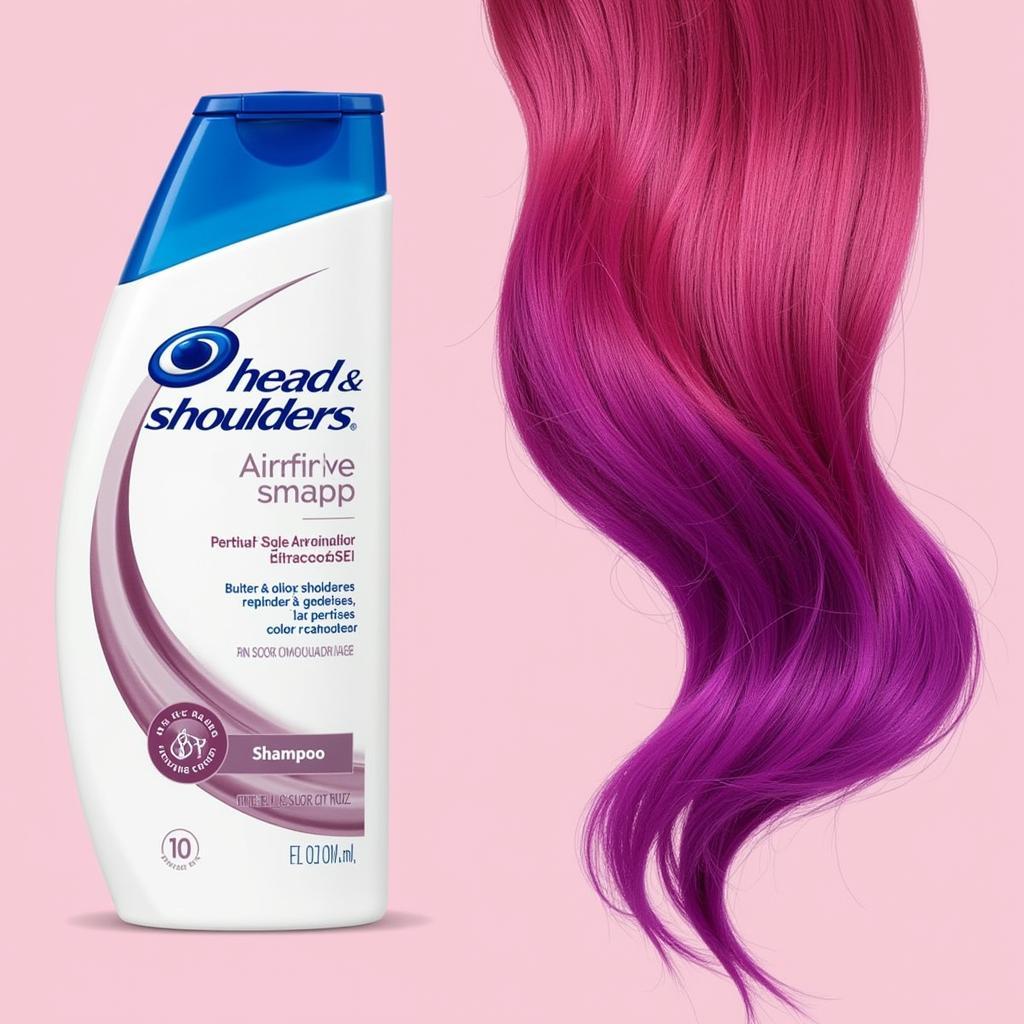Does Head and Shoulders strip hair color? This is a common question for those who color their hair and want to keep their locks vibrant and healthy. While Head and Shoulders is known for its effectiveness against dandruff, concerns exist about its potential impact on hair color. Let’s dive deep into this topic and explore the relationship between Head and Shoulders and color-treated hair.
Head and Shoulders shampoos contain sulfates, specifically sodium lauryl sulfate and sodium laureth sulfate. These are cleansing agents that create the lather we associate with shampooing. While effective at removing dirt and oil, sulfates can also contribute to color fading, especially in freshly colored hair. Does this mean you have to sacrifice a healthy scalp for vibrant color? Not necessarily. There are ways to minimize the impact of Head and Shoulders on your hair color.
How Sulfates Affect Color-Treated Hair
Sulfates work by opening the hair cuticle, which is the outermost layer of the hair shaft. This allows them to effectively clean the hair and scalp, but it also makes the color molecules more susceptible to being washed away. This is why color-treated hair can appear dull or faded after using shampoos containing sulfates. Understanding the science behind this process can help you make informed choices about your hair care routine. If you’re worried about dry shampoo and its effects on colored hair, you might find this article helpful: is dry shampoo bad for colored hair.
Minimizing Color Fading with Head and Shoulders
There are several strategies you can employ to minimize color fading if you use Head and Shoulders. Washing your hair less frequently allows the color to set and reduces the exposure to sulfates. You can also try using cooler water when washing, as hot water can open the hair cuticle more than cool water, leading to increased color loss. Another helpful tip is to concentrate the shampoo on your scalp and avoid applying it directly to the colored strands. Focus on cleansing the roots where dandruff tends to occur and let the lather rinse through the rest of your hair.
 Head and Shoulders shampoo and color-treated hair
Head and Shoulders shampoo and color-treated hair
Does Head and Shoulders Fade Hair Color? Exploring Alternatives
While Head and Shoulders can fade hair color, especially in the initial days after coloring, it doesn’t necessarily strip it completely. The degree of fading depends on factors such as the type of hair color used, the frequency of washing, and the individual’s hair porosity. If you’re unsure about how different hair products might affect your color, exploring articles like “Will head and shoulders strip hair color?” and “Is head and shoulders safe for color treated hair?” can provide valuable insights. You can find answers to these questions at will head and shoulders strip hair color and is head and shoulders safe for color treated hair.
If you find that Head and Shoulders significantly impacts your hair color, there are sulfate-free alternatives available. These shampoos cleanse the hair and scalp without the harsh stripping effect of sulfates, making them a suitable option for color-treated hair.
Choosing the Right Products for Your Hair
Selecting the right hair care products is crucial for maintaining both scalp health and color vibrancy. Consider consulting with a hair stylist or colorist to get personalized recommendations based on your hair type and color. They can provide expert advice on choosing products that address your specific needs. If you’re curious about temporary hair color options and how they wash out, you can find information on does spray hair color wash out. Additionally, understanding how Head and Shoulders might fade hair color can help you manage expectations and adjust your routine. For more information, visit does head and shoulders fade hair color.
“Choosing the right shampoo for color-treated hair is a balancing act,” says renowned hair colorist, Amelia Dubois. “You want to maintain scalp health without compromising the vibrancy of your color. Sulfate-free options are often a great choice for color-treated hair.”
In conclusion, while Head and Shoulders may contribute to some color fading due to its sulfate content, it doesn’t necessarily strip hair color entirely. By adopting strategies like less frequent washing, using cooler water, and focusing the shampoo on the scalp, you can minimize color loss. If you’re still concerned, consider exploring sulfate-free alternatives. Ultimately, the best approach is to understand your hair and choose products that cater to its specific needs, ensuring both a healthy scalp and vibrant, lasting color. does head and shoulders strip hair color? The answer depends on several factors, but with informed choices and a tailored hair care routine, you can maintain both healthy hair and vibrant color.
FAQ
-
Can I use Head and Shoulders on color-treated hair? Yes, but be mindful of potential color fading, especially in the first few washes.
-
What are sulfates, and how do they affect hair color? Sulfates are cleansing agents that can open the hair cuticle, potentially leading to color fading.
-
Are there sulfate-free alternatives to Head and Shoulders? Yes, many sulfate-free shampoos are available that can effectively cleanse the scalp without stripping color.
-
How can I minimize color fading when using Head and Shoulders? Wash less frequently, use cooler water, and focus the shampoo on the scalp.
-
Should I consult a hair stylist about using Head and Shoulders on color-treated hair? Yes, a stylist can provide personalized advice based on your hair type and color.
-
What can I do if Head and Shoulders fades my hair color significantly? Consider switching to a sulfate-free shampoo or exploring other dandruff-control options.
-
Are there any other factors that can affect how Head and Shoulders interacts with hair color? Yes, factors like hair porosity and the type of hair dye used can also play a role.
Common Scenarios
-
Scenario 1: You just colored your hair and noticed some fading after using Head and Shoulders. This is common due to the sulfates in the shampoo. Try the tips mentioned above to minimize fading.
-
Scenario 2: You’ve been using Head and Shoulders for years and have noticed increased color fading recently. This could be due to changes in your hair or the product formula. Consider consulting a stylist or trying a different shampoo.
-
Scenario 3: You’re hesitant to use Head and Shoulders because you’re worried about stripping your hair color. Try a sulfate-free alternative or a clarifying shampoo once a week to remove product buildup.
Further Reading
For more information on hair care and color maintenance, you might find these topics helpful:
- How to protect your hair color from fading
- Best shampoos for color-treated hair
- The science of hair color
Need more assistance? Contact us at Phone Number: 0373298888, Email: [email protected] or visit our address: 86 Cầu Giấy, Hà Nội. We have a 24/7 customer service team ready to help.
